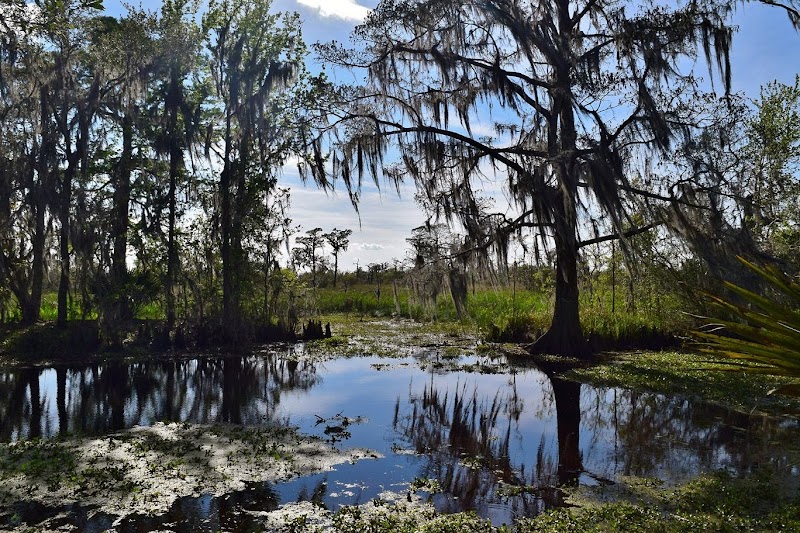
Jean Lafitte National Historical Park and Preserve Adventures
Jean Lafitte National Historical Park and Preserve offers a captivating blend of natural beauty and rich cultural history along the swamps and bayous of Louisiana.
Popular Activities
Explore the Wild Spirit of Jean Lafitte National Historical Park and Preserve: A Hiker's Paradise
Perched on the edge of civilization and the untamed wild, Jean Lafitte National Historical Park and Preserve invites adventurers to meander through a landscape where nature and history intertwine. Stretching across lush wetlands, dense forests, and winding waterways, this Louisiana gem serves as a living museum, preserving not just the echoes of the past but also the vibrancy of the present.
As you step into this remarkable preserve, the light dappled by the towering cypress trees welcomes you, each trunk speaking stories of endurance, while the gentle rustling leaves draw you deeper into a world alive with the sounds of nature. Prepare to immerse yourself in a symphony of bird calls—herons, egrets, and the occasional kingfisher all compete for your attention against a backdrop of swaying Spanish moss that hung lazily like an old curtain, ready to reveal secrets of the bayou.
The hiking trails here offer a profound connection to the environment, taking you through varying terrains that reveal the intricate beauty of the ecosystems at play. The trails range from leisurely strolls to more engaging hikes, making them suitable for both novice and seasoned hikers. If you’re keen to kick off your boots and get immersed in Louisiana’s wildlife, you can expect distances from one to five miles, with most trails providing educational signage along the way.
As you embark on your journey, ensure you’re equipped for the conditions. Lightweight, moisture-wicking clothing will keep you cool in the humid climate, while sturdy footwear will provide the support you need for transitioning between soft earth and the occasional rugged patch. Don’t forget to pack plenty of water; also consider a small snack to power through as the alluring aromas of nature—the rich earth and floral scents of wildflowers—will surely tease your senses.
Take particular note of the diverse habitats that you’ll traverse. The marshes here are not just for show; they are a vital component of Louisiana's ecology, safeguarding countless species, including the elusive alligator. As you navigate these waters, you’ll find yourself watching for movement—be it a splash that indicates a fish, or a subtle ripple signaling the passage of a swampland creature. Firmly planted in the heart of the preserve are boardwalks that offer a unique vantage point, allowing you to observe life thriving both above and below the water’s surface.
For those looking to explore beyond just the trails, consider the “Cultural History” segments of the park. The visitor center provides a wealth of information regarding both the natural and cultural significance of this area. Interactive exhibits complement the experience, making it a worthwhile stop before or after your trekking adventures. Here, you can learn about the rich heritage of the bayou, including the legacy of pirate Jean Lafitte, after whom the park is named.
Timing your hike is key for an optimal experience. Early mornings are magical; the cool air is invigorating, and mist rising off the water transforms the landscape into an ethereal painting. Conversely, if you venture out in the late afternoon, prepare to be greeted by the beautiful, golden hues of sunset reflecting off the water—the world ablaze in colors that nature only seems to conjure at day’s end.
Each step in Jean Lafitte National Historical Park and Preserve is more than a mere hike; it’s a dance with the wild, an exploration of the land’s rich heritage, and an invitation to lose yourself in the beauty and rhythm of Louisiana. Whether you're drawn here by history, environment, or sheer wanderlust, the allure of these trails compels you to return again and again, stirring the adventurous spirit that thrives in us all.
Plan Your Visit
Everything you need to know to prepare for an unforgettable trip to Jean Lafitte National Historical Park and Preserve.
Entrance Requirements
Entry is free but some cultural events may have fees.
Best Time to Visit
Fall and winter for pleasant weather and lower mosquito activity.
Visitor Information
French Quarter, Acadian, and Prairie Acadian Cultural Centers.
Getting There
Easily accessible from highways; watch for local speed limits.
Weather & Climate
Hot, humid summers; mild winters. Frequent afternoon thunderstorms during summer. Best to visit in fall or spring.
Conservation Efforts
Coastal erosion, habitat loss, and the impacts of climate change are ongoing concerns for the preserve’s ecosystems.
Camping in Jean Lafitte National Historical Park and Preserve
Find the perfect spot to stay overnight and immerse yourself in the details.
Top Trails
Bayou Coquille Trail
A short, wheelchair-accessible trail through cypress swamps.
Palmetto Trail
Features picturesque views of bayous and dense palmettos.
Marsh Overlook Trail
Leads to a scenic overlook for marsh vistas and birdwatching.
Trailblazer Tips
Wear mosquito repellent, especially during summer months.
Visit during fall or winter for cooler temperatures and fewer mosquitoes.
Check visitor center sites for free events and cultural demonstrations.
Bring binoculars for better wildlife viewing experiences.
